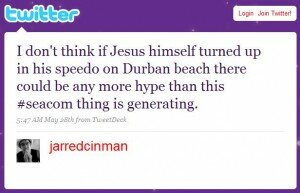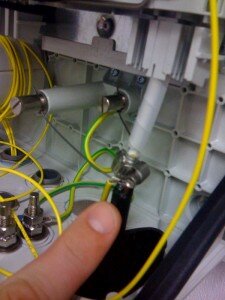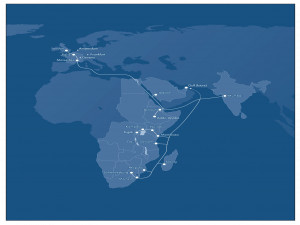SEACOM – What now?!
I was invited to attend the media conference for the grand arrival of SEACOM, the saviour of international bandwidth in Africa, recently and these are my thoughts!

The idea behind SEACOM, is that they have layed down an undersea fibre-optic cable to join India, Europe and Africa in a massive loop of international data transfer, which essentially hooks Africa into the internet, providing massive amounts of data traffic to surge in and out of Africa.

The well organised event was very different to the standard media launches which are normally full of news agency reporters and photographers. Instead, the event had a bus full of Twitterati, the who’s who of the Social Media scene in SA where flown in from Johannesburg and Cape Town. It was very evident that this plan worked superbly well, by the amount of real-time tweeting that took place and which generated so much hype about SEACOM on Twitter that this tweet by @Jarredcinman was inevitable.
We met the CEO of SEACOM, a pretty young, well spoken guy, who chatted to us about some of the challenges that they have faced during the project, the potential benefits, the costs and his excitement at being this far in the project.
 Brian Herlihy, SEACOM CEO, said: “The team has made tremendous progress over the past couple of months and we are truly excited to finally have the finish line in-sight.
Brian Herlihy, SEACOM CEO, said: “The team has made tremendous progress over the past couple of months and we are truly excited to finally have the finish line in-sight.
“With the system substantially completed and testing underway, we are one step closer to delivering on our commitment and become the first project to provide eastern and southern African retail carriers with equal and open access to inexpensive bandwidth.”
We were then taken to visit the site where the cable lands in SA, along the Kwazulu-Natal coast. It was quite interesting to see and it certainly is an amazing set up.
Some facts:
- The backup generators and battery has the capacity to run the cable for about 30 days without any support from ESKOM or refilling the generators.
- The main cabin houses equipment to the value of about R55 million rand.
- The cable leaves SA underground, though the beach and comes out undersea about 1km from the shore and goes as much as 800m deep.
- The cable itself is about as thick as a hair, but the protective sheath is about 2inches thick.
- The cable has a max capacity of 1.28Tbs. Current SA bandwidth uses a 130Gbs cable.

Now, since the massive Twitter hype created yesterday and flurry of blog posts, I have noticed that many people don’t quite understand what SEACOM is and how it will affect us. This is an opinionated schpeel, so if you are pedantic, sorry for you ma chyna!
SEACOM is link between South Africa, Mozambique and a host of other African countries to the global internet. It will carry data to and from our local networks within our borders and drag it undersea, along the east coast of Africa and into the mass of Cyberspace that sits internationally.
SEACOM is NOT an ISP. SEACOM will not provide consumer targeted products and will never be in business of connecting homes, offices, etc to the internet. Instead, it is a B2B company that will sell its products to companies that will onsell bandwidth to consumers. So, the Vodacoms, MTNs, ISs, Telkoms and Neotels and other ISPs will be the customers to SEACOM. Mostly those companies with local network infrastructure that can plug into SEACOM’s international line.
So what is the benefit to the consumer?
Previously, all our international bandwidth used to be transported over another international cable, which had the data capacity of about 130Gbs. SEACOM will provide an alternate cable to these ISPs which have the capacity to carry about 10 times the amount of data per second as our current provider does, at a speed of 1.28Tbs (thats a lot!).
So with this additional competition, ISPs will have the freedom of choice, instead of being tied into a monopoly. Competition will therefore affect pricing and we will see a drop in price as more and more ISPs begin to shift over to SEACOM, creating a competitive market to supply bandwidth to ISPs.

SEACOM’s CEO says that pricing has the capacity to reduce as much as 50% of the current consumer prices that we pay for access to the internet. My opinion is that while this is true, I do not foresee this actually filtering down to teh consumers as aggressively as this. I predict upto 25% price reduction to consumer for data charges within the next year.
The speed is however an altogether different story. The speed that consumers receive its bandwidth is limited by the capacity of the LOCAL networks. So if Telkom’s infrastructure can feed us access at a speed of 4MBs, that is the max speed that consumers would be able to receive data. Local network capacity is what limits South African consumers from 50MBs fixed line broadband connectivity to the home. Only until local network capacity has been improved, will the true effect of the speed implications of the SEACOM cable be passed onto consumers.
It’s not all doom and gloom though. We have all come to accept that Telkom will most likely not upgrade its local network capacity anytime soon, but the GSM networks are keen to change this. Vodacom and MTN are both actively pursuing LTE driven networks, which will extend the capacity of 3G to about 100MBs to the consumer.
This of course will not be an overnight shift and while MTN actively upgrades its network to a capacity of 7.2MBs, we can be certain that projects are in place to handle this LTE evolution. Issues that would concern the consumer, would undoubtedly be the cost of hardware and the fear of traditionally high bandwidth costs.
These changes will not happen soon though. So if you were planning on holding your breathe, I strongly urge that you reconsider this plan. Local networks will phase the benefits of this new competitive pricing wars that are soon to start in order to maximise profits, ensure redundancy and allow for product development to catch up with the potential onslaught of true broadband services that it will allow.
Imagine a converged service of 1000 TV channels of which 350 of them are in Full HD, Unlimited phone and uncapped internet acces through a 50MBs line to your home. This is what the CEO of SEACOM has at his apartment in New York, and its his mission to make it a reality in Africa.

My predictions
- Increased cap sizes at the same prices that we pay now.
- Mobile operators will drive the speed issue more than fixed line operators as a result of incapable local fixed line infrastructure.
- Prices on a per GB basis will drop by about 25% within a year but we should start seeing a better Rand/GB ratio next year sometime.
- Converged services will not be popular in SA, so don’t expect to see triple-play solutions, TV, Internet and Phone, in SA anytime soon as it is controlled by different sector players in SA. E.g. Naspers will not kill Multi-Choice to pump MWEB and Telkom will not kill their revenue driver, PST phone, for IP based solutions.
Other SEACOM Media event posts worth checking out:
From the Couch
Tech Start News
Charl Norman
The Digital Edge





Minnaar Pieters
June 1, 2009 at 4:07 amExcellent take on the Seacom visit. I agree with your predictions, but you might want to add that we wait for a "disruptor"- someone who is going to start the price war... Nice meeting you!
DChetty
June 1, 2009 at 1:48 pm@Minnaar - Agreed. I predict the disruptor being Neotel, as they are the only independent local network and have access to SEACOM already. They are also in need of a land grab to ramp up its subscriber numbers to maintain competitiveness with the large subscriber bases of Vodacom, MTN and Telkom. I am not sure that a disruptive player will be enough to shake the market. Cell C & Virgin tried with little immediate effect on the market, though the circumstances are vastly different. Great meeting you too dude!
Hendrik
June 1, 2009 at 2:03 pmNice article .. I am just wondering why there are no time frames in your article.. do you think we will see a price change in July and a full on price war closer to the end of the year. The CEO stated the uncapped internet .. hmmm that sounds good but realistically that is 5 years away I think.. Thanks for sharing your experience and first hand experience..
DChetty
June 1, 2009 at 2:11 pm@Hendrik - I highly doubt that consumers will see ANY change in July. I think that it would be safe to expect change trickle down to consumers before the end of the year. There is a lot of local network work, billing systems, etc that need to be adapted to support an agile bandwidth market. Uncapped solutions are already available, though premiumly priced. I do expect uncapped solutions become more popular & more consumer targeted with respect to price. So in short, expect a 4MBs uncapped solution for less than R1000 within 18 months.
justinspratt
June 1, 2009 at 2:57 pmgood post - agree with minaar pieters. prices wont substantially shift within 12 months UNLESS there is an irrational price war
DChetty
June 1, 2009 at 3:04 pm@JustinSpratt - Thanks mate. Minnaar speaks the truth, though I am not quite sure than aggressive "price war" will take place. Consumers are not as price sensitive as we think. Quality of service, brand recognition and convenience are factors that play just as critical a role as price when choosing an ISP.
Jellyfish
June 1, 2009 at 3:31 pmI am trying to apply this article to Kenya's experience and think that in Kenya it will be different. In Kenya Seacom will face direct competition from TEAMS another fibre-optic cable built by the govt from Fujairah UAE. The vibrant cellphone industry will fight a massive price war to attract data subscribers and bundled services are already looking promising. I am hopeful that once prices drop around Africa they will also prompt South Africa to drop it's own prices because it will begin to lose comparative advantage if it keeps them artificially high.
Alistair
June 2, 2009 at 2:30 amExcellent overview - thanks very much. I think your predictions are going to be spot on. I wonder, though, if the wireless operators will really be able to push the speed angle as hard as they'd like. In my experience you don't even get 50% of the promised speed - usually 25%. I agree with you on the triple play stuff - you really need a vertically integrated cable TV network for that to make business sense.
Jarred Cinman
June 2, 2009 at 4:17 amThanks for the honourable mention :) This week's episode of The Digital Edge (www.thedigitaledge.co.za) has some real interviews with some real people from the real trip, including Mr Chetty himself. So check it out.
Pingback: What is SEACOM? | iMod
Haroun Kola
June 2, 2009 at 1:30 pmThanks for this article. SEACOM promises lots, lets hope we get to see the benefits soon, our webentrepreneurs in the country need easy and cheap access to the internet, instead of current nightmare we have. Congrats on the new phone you won too :)
DChetty
June 2, 2009 at 2:49 pm@Jellyfish - I can not comment on the Kenyan landscape, but I am fairly certain that your climate is more competitive that that of South Africa's. SA was stuck in a monopoly for a while and this is a GREAT relief for us. @Alistair - Thanks for the comment dude. And welcome to my blog! I agree, we never quite get the speed that we pay for, but these are things that are difficult to manage and easy for the operators to make excuses about. Things won't change in that respect. @Jarred Cinman - Welcome to my blog and thanks for the comment. @Haroun Kola - Thanks for the comment. I agree, positive changes on the bandwidth front will only boost the local ICT sector that is already flourishing in SA amongst the web junkies. I'm so excited about the phone! :)
Pingback: Thoughts about the Seacom cable: what it isn’t and what it can be | Paul Jacobson
Melissa
June 5, 2009 at 11:58 amGreat explanatory in-depth post that I will most definitely refer people back to - nice work :)
DChetty
June 5, 2009 at 3:05 pm@Melissa - Thanks :). I hoped to clarify all the misunderstandings that people have about SEACOM. The divide between those in the know and those who are not is very scary and I truly hope that this gap closes!
Daniel
June 22, 2009 at 3:50 pm"Consumers are not as price sensitive as we think. Quality of service, brand recognition and convenience are factors that play just as critical a role as price when choosing an ISP." I'd say consumers here are used to paying over the odds for basic services. If a company has the balls, and vision, to come in and offer X for less, why would a consumer not move. Let's face it, competition is good. SA has operated on a monopoly for way too long.
Pingback: No big Internet price drops in SA "for another 12 months" « Orion Spur
Aslam Levy
August 25, 2009 at 6:40 amYou've been on the money with your predictions till this point. Nice :)
DChetty
September 2, 2009 at 9:57 am@Aslam Levy - So far, I have been pretty much correct with my predictions. Especially since MWEB has now also increased its cap sizes but maintained its price point. Expect other ISP's to follow suit.
Qamal Wimax
December 28, 2009 at 10:48 amYou made some good points there. I did a search on the topic and found most people will agree with your story.
Jack Beckford
March 14, 2010 at 10:00 amSuperb information, thanks very much.